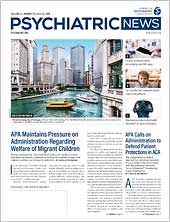APA and five other medical association partners issued a set of principles to Congress last month that are central to addressing the opioid epidemic through legislative and regulatory means.
These joint principles provide guidance on how to expand access to treatment for opioid use disorder (OUD), as well as recommendations for increasing research on substance use disorder treatment and prevention. The foundation that ties all the principles together is a need to recognize OUD (and all substance use problems for that matter) as a chronic disease of the brain that requires evidence-based, public health strategies.
In addition to APA, the partner organizations—known as the Group of Six—are the American Academy of Family Physicians, American Academy of Pediatrics, American College of Obstetricians and Gynecologists, American College of Physicians, and American Osteopathic Association. Together they represent more than 560,000 physicians and medical students.
“As a society, we need to ensure that people struggling with opioid use disorder—and this includes family members as well as patients—have access to comprehensive care,” said APA President Altha Stewart, M.D., in a statement. “Just like people with any other chronic illness, these patients must have coverage for treating a chronic brain disease. The doctors who treat them must be able to respond quickly during relapses and to provide ongoing care management without administrative delays that can lead to emergencies, inpatient care, or other high-cost treatment.”
Many suggestions are well-known policy goals such as increasing the availability of the opioid overdose drug naloxone and reducing the administrative burdens associated with prescribing medications like buprenorphine. However, the principles also address some overlooked aspects of the opioid crisis.
One example is the need to address the maternal-child impact of OUD. The joint principles noted how more than one-third of the children who entered foster care in 2016 did so at least in part because of parental substance use. APA and its medical partners encourage policies that prevent unnecessary foster care placements and keep families together. Numerous studies have shown that substance use by parents creates traumatic stress for children; subsequent family separation exacerbates this stress. One potential solution is to place children with their parent in a residential substance use treatment facility designed to treat the needs of both together.
The rise in opioid use has also led to an increase in infants experiencing neonatal abstinence syndrome, a condition associated with drug withdrawal in newborns exposed to opioids or other drugs in utero. To adequately address this issue, the principles call for not only treating the newborn, but also retaining the mother-baby relationship during treatment. They also point out the need to address the disparities in treatment access facing pregnant and parenting women with OUD. ■
“Addressing the Opioid Epidemic: Joint Principles” can be accessed
here.
